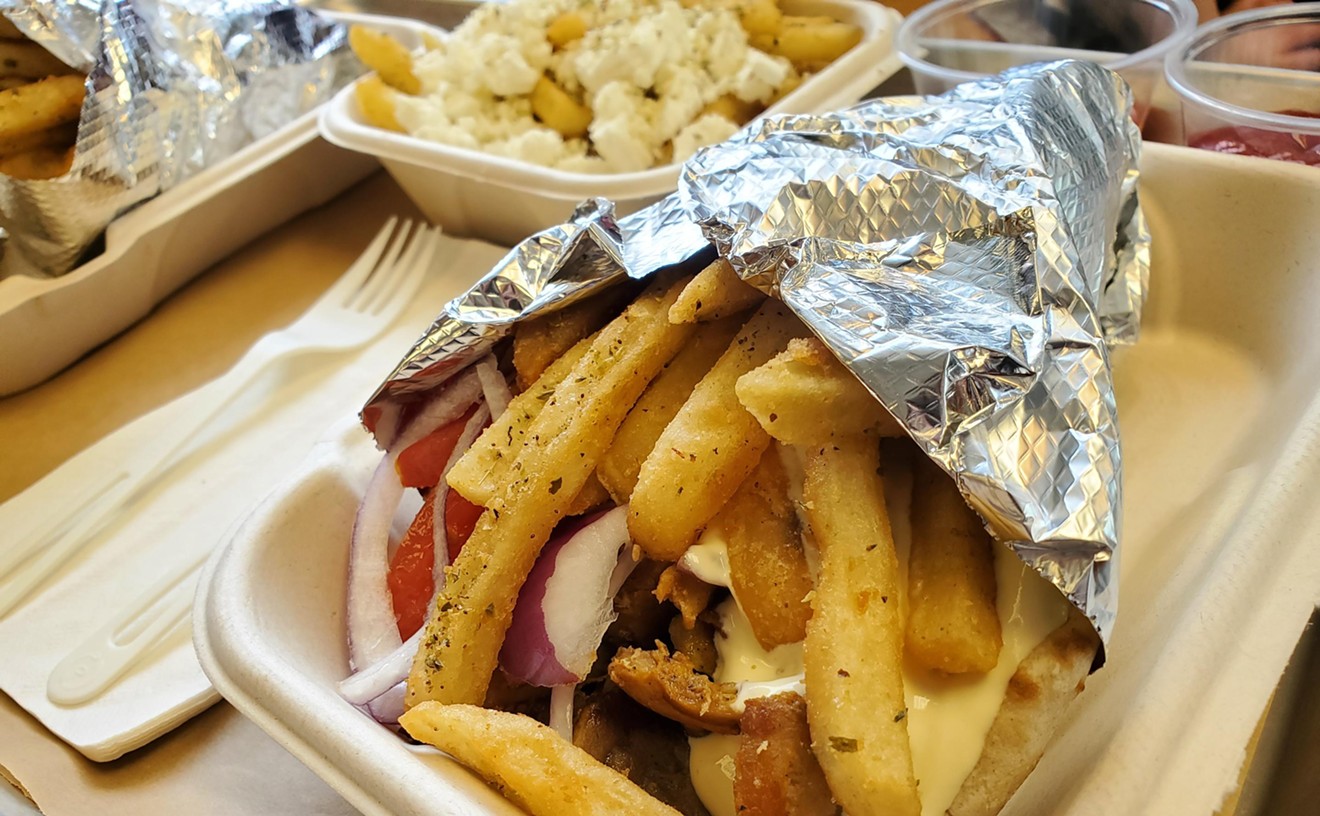The word “serendipity” derives from a Persian fairy tale about the three princes of Serendip, who were blessed with fortunate coincidences, so it seemed somehow appropriate that after exploring three international markets (none Persian), I serendipitously came home with all the makings for traditional Salvadoran pupusas — when I’d started out looking for a Chinese ingredient.
My goal had been to visit a few markets I’d been meaning to check out for the past several months. The first was A Mart, at 3770 East 40th Avenue (just west of Colorado Boulevard), an Asian wholesale grocery store that I’d first noticed when searching online for places to buy a specific Chinese bean paste. After receiving an e-mail from someone looking for a Sichuan broad-bean paste called doubanjiang, I’d called a number of markets to find some. The folks at A Mart seemed particularly friendly, so I eventually made it over and discovered a large, clean and well-stocked grocery store that’s open to the public, even if restaurants are its main customers.
A Mart doesn’t stock the particular brand of doubanjiang my e-mail acquaintance wanted, but I found several other brands in the Chinese-condiments section. The paste is made from fermented broad beans and soybeans; many brands available were more industrialized versions with a similar but less intense flavor than the kind made in the traditional manner (fermented outdoors in large clay vessels). If you’re making mapo tofu at home, which is what I was planning to do, doubanjiang is an essential ingredient. I picked a brand that had the fewest ingredients listed on the label and grabbed a jar of garlic-chile paste to up the heat level.
While there, I also purchased a few other ingredients for mapo tofu: soft tofu, fresh ginger and Sichuan peppercorn, the tongue-numbing spice that gives Sichuan cuisine its distinct character. Ground pork was only available in restaurant-sized packages of ten pounds or more, so that item would have to wait for a trip to my neighborhood grocery store.
A Mart doesn’t have the huge variety of other Asian supermarkets like H Mart or Pacific Ocean Marketplace, but the produce section is as good as any I’ve seen in town, with fresh, vibrant fruits and vegetables and a whole case full of herbs and other hard-to-find greens — and hardly a wilted leaf to be seen. For no particular reason, I picked up a nice-looking cabbage head and grabbed a big handful of fresh Thai chiles, thinking they would be a good source of additional heat for the mapo tofu.
Those two ingredients would form the first part of my dive into serendipity.
My next stop was Tienda Salvadoreña, a small shop at 5128 East Colfax Avenue that I’d passed a hundred times without ever stopping in. The place is a little timeworn and doesn’t have a huge selection; produce was mostly in the form of sweet yellow plantains. I poked around and noticed a variety of prepared foods and snacks from several Central American countries; Tienda seems like a place for Guatemalan, Costa Rican and Nicaraguan immigrants to go for nostalgic tastes of their home countries. The clerk explained that Costa Ricans in the neighborhood come specifically for big bottles of Salsa Lizano, which is used in or on everything from beans to tamales and is a common table condiment in many Costa Rican restaurants. I skipped the Lizano and also passed up a bag of morro seeds, which are used in El Salvador to make a version of horchata that’s much different from the rice-based Mexican drink.
In the refrigerated section, I noticed blocks of “quesillo para pupusas,” cheese made specifically for griddled Salvadoran snacks. I bought a package, thinking it would be good for quesadillas, if nothing else. But serendipity would have other plans for my cheese.
Finally, I pulled into the cramped parking lot at Mi Pueblo Market, 125 Knox Court — an easy stop on my way home, but one I had never made for some reason. Mi Pueblo’s produce section was a little disappointing, with wilted herbs and blackening chiles. I occasionally check in at Mexican grocery stores around my neighborhood for seasonal produce, so I usually keep an open mind and make a couple of passes to be sure I haven’t missed anything. It was on a second pass at Mi Pueblo that I noticed a couple of Styrofoam packs of loroco, a tropical flower bud used with stringy white cheese for stuffing Salvadoran pupupas. Loroco is also sold in jars, but don’t buy that stuff; it’s flavorless and limp and makes a poor substitute for the fresh, green buds.
I’d never seen fresh loroco in Denver before, and I realized that with this purchase, I now had everything I needed to make some traditional pupusas. I keep Maseca masa harina in my pantry, so I already had the right ingredient to make the dough, and the cabbage and chiles from A Mart would be perfect for cooking up a fiery batch of curtido, the slaw-like accompaniment to any complete platter of pupusas.
I also had nearly everything I needed to make the mapo tofu I’d planned, though that would have to wait for another night. I knew the loroco wouldn’t last more than a day or two, so pupusas were now on the menu. One thing that would definitely not be accompanying my pupusas was the bottle of La Cascadia Kolashampan the clerk at Tienda Salvadoreña had talked me into purchasing, telling me it was the favorite soda of Salvadorans. I may lose my street cred in San Salvador, but the stuff tasted like bubble gum and went straight down the drain. I’ll stick with an ice-cold beer to wash down my serendipity, thanks.
Here's a recipe for pupusas with curtido.
Ingredients:
1 bag of Maseca masa harina
1 block of quesillo para pupusas, or any white melting cheese (like Oaxacan cheese available in most grocery stores)
Fresh loroco (or a substitute, not jarred loroco. See below.)
1/2 head of cabbage
1 carrot
4 Thai red chiles (or other small, fresh chiles that pack a punch)
Vinegar
Sugar
Dried oregano
Salt
For the pupusa dough, follow the directions on the Maseca bag for a single batch of tortillas, adding a healthy pinch of salt to the mixture of water and masa harina. Roll the dough into several equal-sized balls slightly larger than golf balls. (I ended up with seven.) Cover with plastic wrap or a towel.
For the curtido, grate half a head of cabbage and one carrot into a bowl and stir in two tablespoons of vinegar (I use apple cider vinegar, but white vinegar would also work). Add a tablespoon of sugar and a teaspoon of dried oregano. Mince the Thai chiles finely and stir in all the ingredients. Salt to taste. Let this sit so that the flavors mingle — you can even make it in advance and keep in the fridge for a day or two. Taste before serving and adjust with vinegar, sugar or salt to your liking. I like my curtido spicy, but if you're not a chile head, use a milder variety and remove the seeds and pith before mincing.
If you're using fresh loroco, rinse them and cut away the thicker stems. The stems are edible, and you can leave the smaller ones, but the thicker pieces tend to be a little fibrous. If you can't find loroco, fresh asparagus tips cut into very small pieces would be a good substitute, but I've also used shredded zucchini. Regardless of which vegetable you use, sauté it in a tablespoon of butter with a pinch of salt for two or three minutes until just soft. Remove from the pan and let cool for a few minutes. You should end up with a cup or two of sauteed vegetables. Precise measurement isn't too important here, as long as you have enough to stuff several pupusas. Shred about a half-pound of the cheese while the veggies are cooling.
To form a pupusa, hold a masa ball in one hand while pressing your thumb into the center of it. Form a thin-walled cup from the ball and fill the hollow with shredded cheese and about a tablespoon of the sauteed loroco (or other vegetable). Wrap the wall of the dough around the cheese and loroco to seal it and gently form it back into a ball, making sure to keep the filling centered. Use a tortilla press or two plates to press the ball into a disk about a quarter-inch thick. It's okay if a little of the cheese or loroco is visible through the dough, but try to keep most of it sandwiched inside of it. Make sure you line the tortilla press or plates with plastic wrap so that the masa doesn't stick. Once pressed, they should be a little smaller than a store-bought corn tortilla.
Heat a wide frying pan or pancake griddle to medium-high and place the pupusas in one at a time, making sure not to crowd them. They may stick a little at first, but will release once they begin to brown. Don't use oil or butter; just cook them using dry heat. Cook for about five minutes on each side. They should be just crisped on the outside with spots of golden brown, but shouldn't be crunchy. The interior should remain soft, and the cheese should melt completely. Don't worry if some of the cheese oozes out while the pupusas are cooking.
Cook the pupusas in two or three batches, depending on how big your pan is. Serve with the curtido. A mild, tomato-y salsa generally accompanies pupusas, too, but I usually just use a bottled hot sauce like Búfalo or Yucateco.
[
{
"name": "Air - MediumRectangle - Inline Content - Mobile Display Size",
"component": "12017618",
"insertPoint": "2",
"requiredCountToDisplay": "2"
},{
"name": "Editor Picks",
"component": "17242653",
"insertPoint": "4",
"requiredCountToDisplay": "1"
},{
"name": "Inline Links",
"component": "18838239",
"insertPoint": "8th",
"startingPoint": 8,
"requiredCountToDisplay": "7",
"maxInsertions": 25
},{
"name": "Air - MediumRectangle - Combo - Inline Content",
"component": "17261320",
"insertPoint": "8th",
"startingPoint": 8,
"requiredCountToDisplay": "7",
"maxInsertions": 25
},{
"name": "Inline Links",
"component": "18838239",
"insertPoint": "8th",
"startingPoint": 12,
"requiredCountToDisplay": "11",
"maxInsertions": 25
},{
"name": "Air - Leaderboard Tower - Combo - Inline Content",
"component": "17261321",
"insertPoint": "8th",
"startingPoint": 12,
"requiredCountToDisplay": "11",
"maxInsertions": 25
}
]











